

By Eric Lindstrom
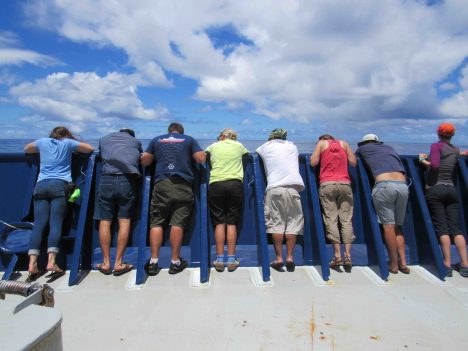
Are we there yet?
A six-week voyage on the open ocean is not for everyone. On this trip we had plenty of veterans and few first timers. Channel fever is commonly considered something that happens at the end of a voyage as you head for port. It is maybe easier for those of you ashore to picture as akin to spring fever at the end of winter. I would like to describe a more comprehensive theory of voyage feelings that is more akin to the five stages of grief. Maybe it should be called the five stages of channel fever?
For grief, the five stages are denial, anger, bargaining, depression and acceptance. For channel fever, the five stages are sickness, interest, boredom, excitement, and port. Like grief, they are not some stops along a linear timeline (except maybe port!), but tools to help us recognize what we are thinking and feeling. In this theory of channel fever it occupies the entire voyage.
Sickness
Getting your sea legs is the first hurdle of the voyage. It starts in the harbor channel and impacts people in different ways. Headaches, queasiness, and overwhelming sleepiness are all symptoms. This phase is definitely a downer and modern medicine has sought to treat it with drugs. Some unfortunates never get past this stage.
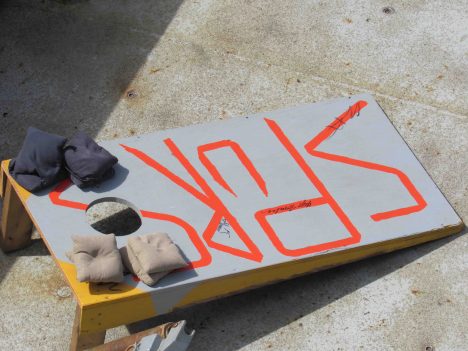
A game devised to forestall channel fever.
Interest
A core feeling early in voyages is interest in all the stuff that other people are doing that of which you have not yet become familiar. The ship is small, so any new things to see or do certainly focus your attention. Good mariners can make the simplest chores and routines the subject of great interest and focus. They know that you should hold this feeling as long as possible. It’s deadly if you move on to boredom too soon. Maybe my blogging style gains strength from this stage of channel fever?
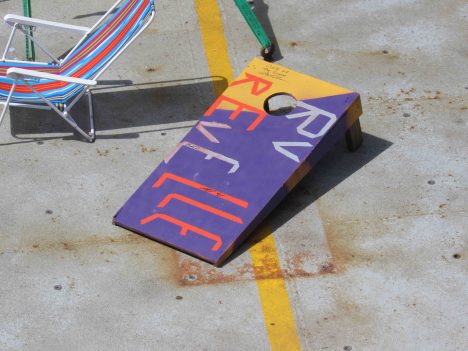
Two teams, eight bean bags and two targets = hours of amusement.
Boredom
Once you have mastered your work and everyone else’s chores, interest fades and boredom takes over. Ideally, you would like this feeling to be minimized. Therefore, sea veterans are adept at invention of new games, procedures, routines, and making anything that is even halfway interesting last as long as possible. You may have wondered why people come back from sea with weird new skills like knot tying or macramé. It’s because of trying to fight boredom!
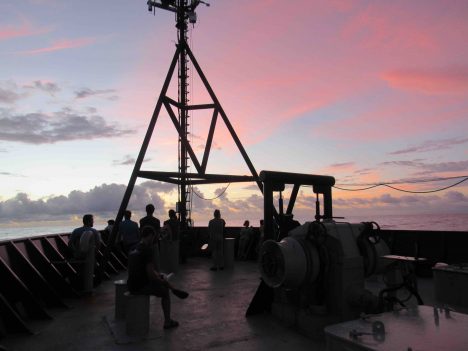
End of a long day of packing and dreaming of home.
Excitement
This is the classic feeling of channel fever and its penultimate stage. Long after sickness, interest, and boredom, it is usually the time when all your hopes hang on finishing the trip and getting back to life ashore. Usually this stage alone is what people refer to as channel fever because the emotional symptoms are closely associated only with proximity to voyage end and no other known cause.
Port
The final stage of channel fever and resolution (in my theory) of the malady come with arrival in port and being homeward bound. Resolution (port) is often a highly celebrated event. The modern cure for channel fever is solid ground and a cold beer. Really, we don’t know if beer has anything to do with this, however there seems to be a close association between beer and miraculous recoveries in port! The science party on R/V Revelle is hosting a post-voyage happy hour ashore later in the day we arrive, just to make sure everyone receives the cure.
Cheers!
By Eric Lindstrom
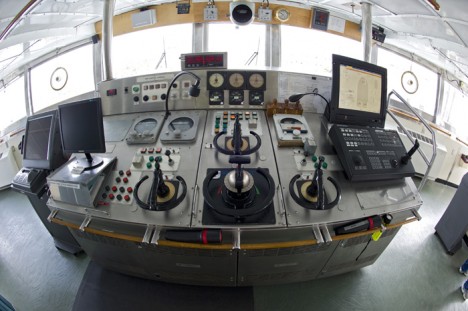
The bridge of the Research Vessel Knorr. (Photo by Tom Kleindinst, Woods Hole Oceanographic Institution.)
Almost everyone can imagine the bridge of a ship – from the movies, a tour of a ship, or maybe you are the master of your own vessel. It is the place where control of all ship operations is commanded. On the bridge of the Knorr, an officer and a seaman are always present and in full control of the vessel, for the safety of all aboard and effectiveness of the ship as a research platform. It’s amazing what they can do and the various skills that are required to command a research vessel.
The bridge and chart room house all the ways and means needed to safely navigate Knorr, maintain her stability, maneuver her on station, and to communicate with anyone as necessary. Like the dashboard of a (sophisticated) car, they have a display of key engineering functions and to operate the ship in both manual (i.e., you driving) and autopilot (car cruise control) modes.
One key function of the master that you may not know about is to complete calculations assessing the stability of the ship and to ballast her correctly as fuel is consumed or heavy scientific gear is deployed. Seawater ballast tanks are available to compensate for changing conditions (Knorr uses between 1,800 and 3,800 gallons of fuel per day).
There is an overarching sense of situational awareness that permeates life on the bridge of any research vessel. The captain and the mates are always alert of changing conditions like weather, location, time, ship traffic, and science plans. With the rhythm of the ship, they are also keenly attuned to watch changes, meals, rest periods, and fresh coffee brewing. Also, there is all the important watch for fish. The chief engineer must be informed 24/7 of any sighting. We all need our protein…
That leaves the oceanographers to focus on the science bits – like what the tiny variations of salinity are in the top 3,000 feet of the ocean! That’s sweet. The bridge looks after us, we look after the ocean, and everyone is, well… working. Not much else to do out here.
Knorr has amazing capability to stay on station. In gentle sea conditions, it’s quite possible to stay on location to within a few feet. The officer on watch can set the ship to keep position, so their attention can be shifted to observing deck operations further aft on the ship.
Captain Adam Seamans has been a Master of Knorr since 2008. He started with Whoods Hole Oceanographic Institution (WHOI) as an Able Seaman in 2000, where one of his first duties was to clean a science cabin after a head overflowed. My, how times have changed! Now he commands the 22-member crew of Knorr and navigates her to all corners of the globe. Maybe he still has to deal with a lot of crumby jobs, but they are mostly of the cleaner variety!
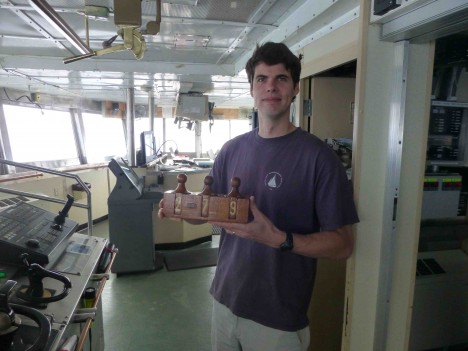
Captain Adam Seamans holding the Knorr’s heading box, which contains three wooden blocks with ten digits inscribed in each. One can set the heading of the ship 0-360 degrees and place this in front of the seaman steering the ship’s course. For the photo, the heading is set at 279 – the length of Knorr in feet.
The Knorr has enormous capability for communication – via satellite phone or internet or radio. In close quarters with foreign vessels, Knorr can communicate the old-fashioned way via flags. Sequences of brightly colored flags have universal meanings to mariners.
Finally, I thought I would call your attention to training. All the officers aboard Knorr have great experience and through my decades of oceanography, I have found maritime officers always passing their knowledge and experience forward to others. Teaching and sharing, honestly, what a great concept! It makes for safer seas.
On this voyage we have a learner, a cadet named Anna, from Sweden. She is just 18 and approached a WHOI captain about being a cadet aboard one of their vessels. Sometimes you need to be careful what you wish for! Anna has been working all the jobs on the ship for our expedition. Just today, she was driving a winch by herself for the first time, looking happy and proud! Her initiative and hard-working nature are an example for all of us. Sometimes the teachers become the students… Anna, Bravo Zulu!